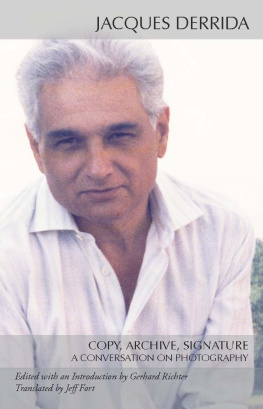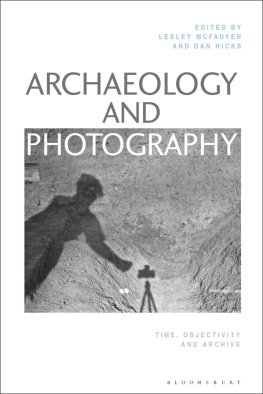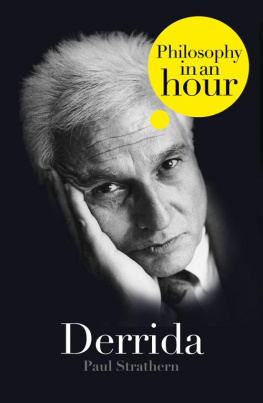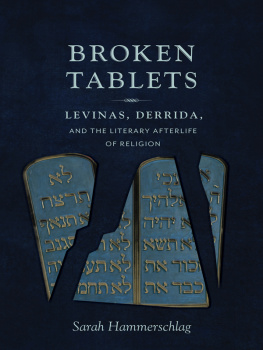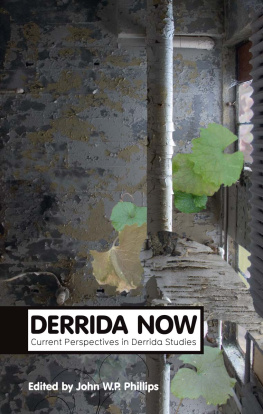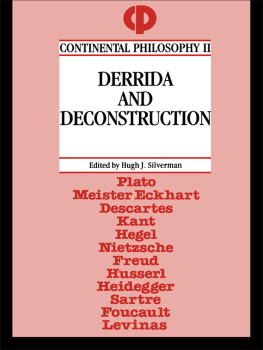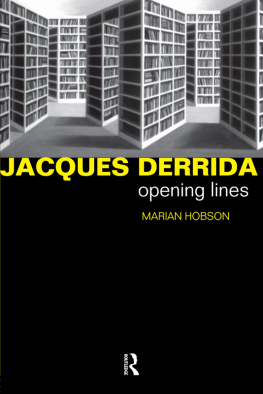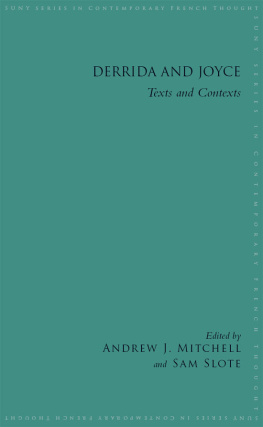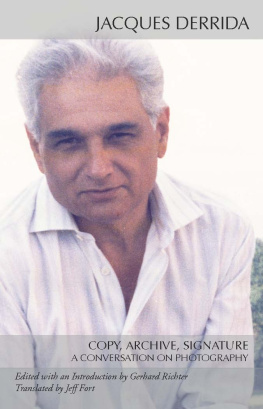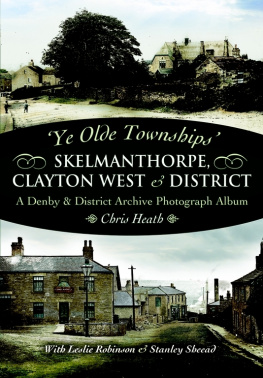Derrida - Copy, Archive, Signature: a Conversation on Photography
Here you can read online Derrida - Copy, Archive, Signature: a Conversation on Photography full text of the book (entire story) in english for free. Download pdf and epub, get meaning, cover and reviews about this ebook. City: Redwood City, year: 2010;2011, publisher: Stanford University Press, genre: Religion. Description of the work, (preface) as well as reviews are available. Best literature library LitArk.com created for fans of good reading and offers a wide selection of genres:
Romance novel
Science fiction
Adventure
Detective
Science
History
Home and family
Prose
Art
Politics
Computer
Non-fiction
Religion
Business
Children
Humor
Choose a favorite category and find really read worthwhile books. Enjoy immersion in the world of imagination, feel the emotions of the characters or learn something new for yourself, make an fascinating discovery.
- Book:Copy, Archive, Signature: a Conversation on Photography
- Author:
- Publisher:Stanford University Press
- Genre:
- Year:2010;2011
- City:Redwood City
- Rating:5 / 5
- Favourites:Add to favourites
- Your mark:
- 100
- 1
- 2
- 3
- 4
- 5
Copy, Archive, Signature: a Conversation on Photography: summary, description and annotation
We offer to read an annotation, description, summary or preface (depends on what the author of the book "Copy, Archive, Signature: a Conversation on Photography" wrote himself). If you haven't found the necessary information about the book — write in the comments, we will try to find it.
Derrida: author's other books
Who wrote Copy, Archive, Signature: a Conversation on Photography? Find out the surname, the name of the author of the book and a list of all author's works by series.
Copy, Archive, Signature: a Conversation on Photography — read online for free the complete book (whole text) full work
Below is the text of the book, divided by pages. System saving the place of the last page read, allows you to conveniently read the book "Copy, Archive, Signature: a Conversation on Photography" online for free, without having to search again every time where you left off. Put a bookmark, and you can go to the page where you finished reading at any time.
Font size:
Interval:
Bookmark:
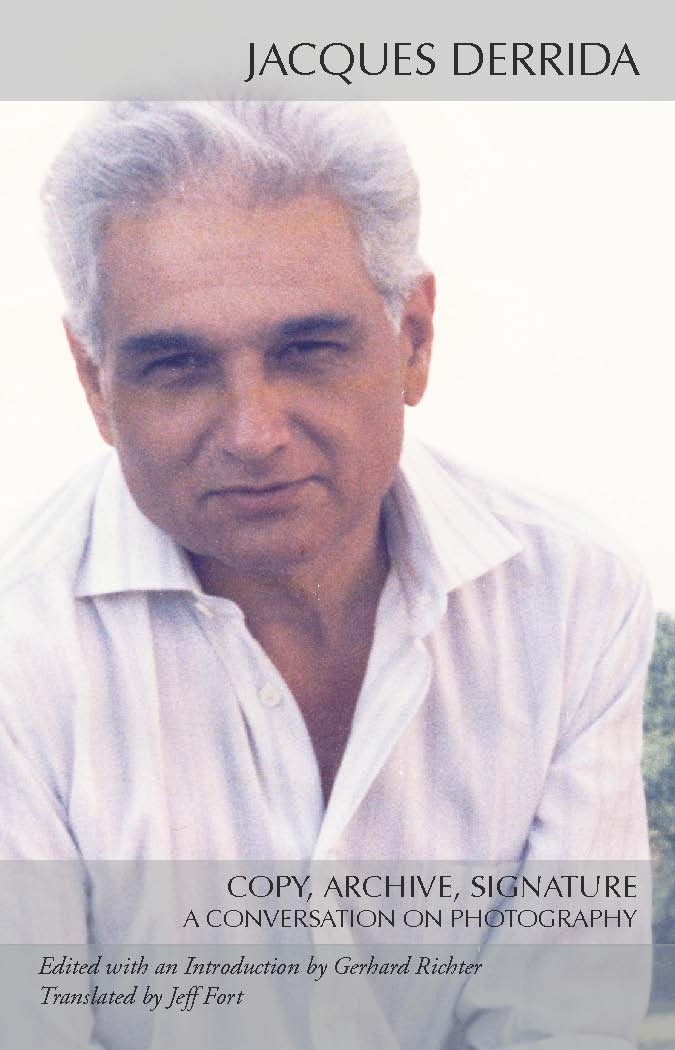
The conversation with Jacques Derrida, as yet unpublished in French, previously appeared in an abridged form in German translation as part of an anthology of theoretical texts on photography under the title Die Fotografie als Kopie, Archiv und Signatur: Im Gesprch mit Hubertus von Amelunxen und Michael Wetzel, in Theorie der Fotografie IV, 19801995 , edited by Hubertus von Amelunxen (Munich: Schirmer/Mosel, 2000). I am pleased to record my gratitude to Hubertus von Amelunxen and Michael Wetzel for permitting the translation of their conversation with Derrida into English and for making available the extant versions of the original French transcript. I owe special thanks to Samuel Weber and a reader who wished to remain anonymous for their perspicacious comments on the project, as well as to Michael Naas, who graciously read the manuscript in its penultimate version. I also am grateful to Pascale-Anne Brault and Michael Naas for sharing a draft of their forthcoming translation of Derridas Demeure, Athnes , and to Pleshette DeArmitt and Kas Saghafi for granting me the droit de regards to their forthcoming translation of Derridas Aletheia. Jeff Fort, my colleague from the Department of French at UC Davis, was a joy to work and think with, and his abilities as a translator are once again admirably on display. Finally, this volume is dedicated to the memory of Jacques Derrida. The lectures and seminars that I attended, as well as our conversations (all too few), are inscribed in my memory like a photographic archive of the rigorous unpredictabilities and excessive responsibilities of thinking itself.
G. R.
September 2009
Jacques Derrida et al., Roundtable on Translation, trans. Peggy Kamuf, in The Ear of the Other: Otobiography, Transference, TranslationTexts and Discussions with Jacques Derrida , ed. Christie McDonald (Lincoln: University of Nebraska Press, 1985), 91161, here 120.
For a detailed history of the words Destruktion and Abbau in Heidegger, beginning with Being and Time in 1927, and its relations to the concept of deconstruction in Derrida and, through him, in Paul de Man, see Jean-Luc Nancy, Our History, trans. Cynthia Chase, Richard Klein, and A. Mitchell Brown, diacritics 20, no. 3 (fall 1990): 97115, here 1025.
A useful general account of Derridas relation to Heidegger, especially as it concerns the early translations of Abbau and Destruktion , is offered by Robert Bernasconi, Heidegger und die DekonstruktionStrategien im Umgang mit der Metaphysik: Derrida, Nancy, Lacoue-Labarthe und Irigaray, trans. Reiner Ansn, in Heidegger-Handbuch: LebenWerkWirkung , ed. Dieter Thom (Stuttgart: Metzler, 2003), 44050, esp. 44045. As Bernasconi points out, Derrida, in a 1966 essay for the French journal Critique entitled De la grammatologie, still employs the term dtruire . One year later, in his book De la grammatologie , this word is silently replaced with dconstruire (441).
Jacques Derrida, Letter to a Japanese Friend, trans. David Wood and Andrew Benjamin, in Derrida and Diffrance , ed. David Wood and Robert Bernasconi (Evanston, IL: Northwestern University Press, 1988), 15, here 4.
Ibid., 45.
For an incisive consideration of the difficulty implied by the heading or title of deconstruction and its history, see Rodolphe Gasch, Without a Title, in Views and Interviews: On Deconstruction in America (Aurora, CO: Davies Group, 2007), 132. Reminding us that even the word deconstruction ought to be placed in brackets in order to remain faithful to its own radicality, Gasch proposes that we leave Derridas thought, and our own, without this title, precisely in the name of an encompassing vigilance of thinking that builds on Heideggers concept of Achtsamkeit and that cannot fully come to us as a name, a heading, or a title without betraying what is most useful in it.
Jacques Derrida, Structure, Sign, and Play in the Discourse of the Human Sciences, in Writing and Difference , trans. Alan Bass (Chicago: University of Chicago Press, 1978), 27893, here 280.
Ibid., 281.
Peter Brunette and David Wills, The Spatial Arts: An Interview with Jacques Derrida, trans. Laurie Volpe, in Deconstruction and the Visual Arts: Art, Media, Architecture , ed. Peter Brunette and David Wills (Cambridge, UK: Cambridge University Press, 1994), 932, here 1920.
Ibid., 14.
Derrida made this confession many times over the years. See, for instance, his 2002 interview with Kristine McKenna for LA Weekly , now included in Kirby Dick and Amy Ziering Kofman (eds.), Derrida: Screenplay and Essays on the Film , foreword by Geoffrey Hartman (New York: Routledge, 2005), no pagination. It would be useful to place Derridas wish, prior to ca. 1980, not to have his photograph published into syntactical relation with some of the previously unpublished photographs of him in Michel Lisse, Jacques Derrida (Paris: Association pour la diffusion de la pense franaise, 2005).
Shortly after I had written this essay, a thoughtful meditation on Derridas relation to the photographic self-portrait appeared: Ginette Michaud, Veilleuses: Autour de trois images de Jacques Derrida (Quebec: Nota Bene, 2009).
Jacques Derrida, The Truth in Painting , trans. Geoff Bennington (Chicago: University of Chicago Press, 1987); Jacques Derrida, Memoirs of the Blind: The Self-Portrait and Other Ruins , trans. Pascale-Anne Brault and Michael Naas (Chicago: University of Chicago Press, 1993); Jacques Derrida, Deconstruction Engaged: The Sydney Seminars , ed. Paul Patton and Terry Smith (Sydney: Power Publications, 2001); Jacques Derrida, with Bernard Stiegler, Echographies of Television: Filmed Interviews , trans. Jennifer Bajorek (Cambridge, UK: Polity, 2002); and Jacques Derrida, Videor, trans. Peggy Kamuf, in Resolutions: Contemporary Video Practices , ed. Michael Renov and Erika Suderburg (Minneapolis: University of Minnesota Press, 1996), 7377.
Jacques Derrida, Demeure, Athnes (Paris: Galile, 2009), an English version of which, translated by Pascale-Anne Brault and Michael Naas, is forthcoming from Fordham University Press under the title Athens, Still Remains ; Athens and Photography: A Mourned-for Survival, Counterpath: Traveling with Jacques Derrida , by Catherine Malabou and Jacques Derrida, trans. David Wills (Stanford: Stanford University Press, 2004), 11819; Trace et archive, image et art, a conversation at the Collge iconique on June 25, 2002, available as a transcript from the French Institut national de laudiovisuel at www.ina-entreprise.com ; Aletheia, in Nous avons vou notre vie des signes, no editor named (Bordeaux: William Blake, 1996), 7581, with an English translation by Pleshette DeArmitt and Kas Saghafi, forthcoming in Oxford Literary Review ; and a series of untitled essays on Brenners photographs, trans. Peggy Kamuf, in Frdric Brenner, Diasporas: Homelands in Exile , vol. 2, Voices (New York: HarperCollins, 2003).
Jacques Derrida, The Deaths of Roland Barthes, trans. Pascale-Anne Brault and Michael Naas, in The Work of Mourning , ed. Pascale-Anne Brault and Michael Naas (Chicago: University of Chicago Press, 2001), 3167; and Jacques Derrida and Marie-Franoise Plissart, Right of Inspection , trans. David Wills (New York: Monacelli, 1998). In a recent essay I have attempted to place Derridas philosophical reflections on photography into syntactical relation with certain moments in the prose of Franz Kafka and in the work of German photographer Stefan Moses; see Gerhard Richter, Unsettling Photography: Kafka, Derrida, Moses, in Remainders: Of Jacques Derrida, ed. David E. Johnson, special issue, CR: The New Centennial Review 7, no. 2 (fall 2007): 15573. I borrow a few sentences from that essay in the present one.
Font size:
Interval:
Bookmark:
Similar books «Copy, Archive, Signature: a Conversation on Photography»
Look at similar books to Copy, Archive, Signature: a Conversation on Photography. We have selected literature similar in name and meaning in the hope of providing readers with more options to find new, interesting, not yet read works.
Discussion, reviews of the book Copy, Archive, Signature: a Conversation on Photography and just readers' own opinions. Leave your comments, write what you think about the work, its meaning or the main characters. Specify what exactly you liked and what you didn't like, and why you think so.

